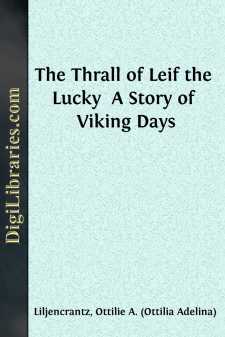Categories
- Antiques & Collectibles 13
- Architecture 36
- Art 48
- Bibles 22
- Biography & Autobiography 813
- Body, Mind & Spirit 142
- Business & Economics 28
- Children's Books 15
- Children's Fiction 12
- Computers 4
- Cooking 94
- Crafts & Hobbies 4
- Drama 346
- Education 46
- Family & Relationships 57
- Fiction 11828
- Games 19
- Gardening 17
- Health & Fitness 34
- History 1377
- House & Home 1
- Humor 147
- Juvenile Fiction 1873
- Juvenile Nonfiction 202
- Language Arts & Disciplines 88
- Law 16
- Literary Collections 686
- Literary Criticism 179
- Mathematics 13
- Medical 41
- Music 40
- Nature 179
- Non-Classifiable 1768
- Performing Arts 7
- Periodicals 1453
- Philosophy 64
- Photography 2
- Poetry 896
- Political Science 203
- Psychology 42
- Reference 154
- Religion 513
- Science 126
- Self-Help 84
- Social Science 81
- Sports & Recreation 34
- Study Aids 3
- Technology & Engineering 59
- Transportation 23
- Travel 463
- True Crime 29
The Thrall of Leif the Lucky A Story of Viking Days
Categories:
Description:
Excerpt
CHAPTER I
Vices and virtues
The sons of mortals bear
In their breasts mingled;
No one is so good That no failing attends him,
Nor so bad as to be good for nothing.
Ha'vama'l (High Song of Odin).
It was back in the tenth century, when the mighty fair-haired warriors of Norway and Sweden and Denmark, whom the people of Southern Europe called the Northmen, were becoming known and dreaded throughout the world. Iceland and Greenland had been colonized by their dauntless enterprise. Greece and Africa had not proved distant enough to escape their ravages. The descendants of the Viking Rollo ruled in France as Dukes of Normandy; and Saxon England, misguided by Ethelred the Unready and harassed by Danish pirates, was slipping swiftly and surely under Northern rule. It was the time when the priests of France added to their litany this petition: "From the fury of the Northmen, deliver us, good Lord."
The old, old Norwegian city of Trondhjem, which lies on Trondhjem Fiord, girt by the river Nid, was then King Olaf Trygvasson's new city of Nidaros, and though hardly more than a trading station, a hamlet without streets, it was humming with prosperity and jubilant life. The shore was fringed with ships whose gilded dragon-heads and purple-and-yellow hulls and azure-and-scarlet sails were reflected in the waves until it seemed as if rainbows had been melted in them. Hillside and river-bank bloomed with the gay tents of chieftains who had come from all over the North to visit the powerful Norwegian king. Traders had scattered booths of tempting wares over the plain, so that it looked like fair-time. The broad roads between the estates that clustered around the royal residence were thronged with clanking horsemen, with richly dressed traders followed by covered carts of precious merchandise, with beautiful fair-haired women riding on gilded chair-like saddles, with monks and slaves, with white-bearded lawmen and pompous landowners.
Along one of those roads that crossed the city from the west, a Danish warrior came riding, one keen May morning, with a young English captive tied to his saddle-bow.
The Northman was a great, hulking, wild-maned, brute-faced fellow, capped by an iron helmet and wrapped in a mantle of coarse gray, from whose folds the handle of a battle-axe looked out suggestively; but the boy was of the handsomest Saxon type. Though barely seventeen, he was man-grown, and lithe and well-shaped; and he carried himself nobly, despite his clumsy garments of white wool. His gold-brown hair had been clipped close as a mark of slavery, and there were fetters on his limbs; but chains could not restrain the glance of his proud gray eyes, which flashed defiance with every look.
Crossing the city northward, they came where a trading-booth stood on its outskirts—an odd looking place of neatly built log walls tented over with gay striped linen. Beyond, the plain rose in gentle hills, which were overlooked in their turn by pine-clad snow-capped mountains....



